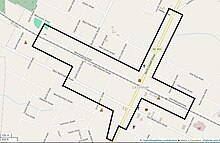LaGrange Historic District | |
 Colonel A. C. Davis House, built in 1887 | |
| Location | Roughly bounded by N. Caswell, E. James, N. Carey, E. Washington, S. Caswell, W. Washington, and Forbes Sts. La Grange, North Carolina |
|---|---|
| Coordinates | 35°18′20″N 77°47′30″W / 35.30556°N 77.79167°W |
| Architectural style | Queen Anne, Bungalow/Craftsman |
| NRHP reference No. | 00000458[1] |
| Added to NRHP | May 11, 2000 |
The La Grange Historic District is a national historic district located ub La Grange, North Carolina, United States. The district, encompassing 225 buildings and 1 structure, includes the historic commercial, residential, and industrial center of La Grange. The buildings include notable examples of Queen Anne and Bungalow/American Craftsman style architecture and date between the 1850s and the 1930s. Located in the district is the separately listed La Grange Presbyterian Church. Other notable buildings include the Sutton-Kinsey House (c. 1898), Walter Pace House (c. 1900), Sutton-Fields House (c. 1850), Colonel A. C. Davis House (1887), Rouse Banking Company Building (1908), LaGrange Elementary School, and the Hardy-Newsome Industrial Complex. It was added to the National Register of Historic Places in May 2000.
Geography

The northern end of the historic district begins just above the intersection of Hadley Street and North Caswell Street. The boundary heads south, running behind the property lines of buildings along the east side of North Cameron Street. The boundary then heads east, behind buildings facing East Railroad Street and ends before North Carey Street. It then crosses the street and railroad tracks to include buildings on the south side of East Railroad Street. This continues until reaching the properties along South Cameron Street, where the boundary heads south. At East Boundary Street, the boundary crosses the road and heads south for around half a block.[2]
It then heads slightly west before turning north again, running behind the property lines of buildings on West Boundary Street, until just past the intersection with South Charles Street. The boundary turns north on South Charles Street and takes a turn west to include the buildings along West Railroad Street. The boundary goes west until crossing School Street. It crosses West Railroad Street and includes buildings that are on the north side of the railroad tracks. After heading east on West Railroad Street, the boundary stops behind the property lines of buildings on North Caswell Street and heads north, stopping on the other side of Hadley Street, where the boundary began.[2]
History
Early history
La Grange, North Carolina, is a small town in western Lenoir County. The town was originally named after an area plantation, Moseley Hall. Like several towns in the area, commercial development and population growth took place after completion of the Atlantic and North Carolina Railroad in 1858. The railroad tracks began in Goldsboro, located west of the town, and ended at Morehead City on the coast. Moseley Hill was renamed La Grange in 1869 when the town was incorporated. La Grange was named after Château de la Grange-Bléneau, the home of American Revolutionary War hero, Gilbert du Motier, Marquis de Lafayette.[2]
Agricultural and commercial products were loaded onto trains, allowing farmers and merchants to greatly increase their businesses. Before the Civil War, the surrounding farms and plantations mostly grew cotton. Prices dropped after the war, hurting the local economy. In the 1890s, area farmers began growing tobacco, a crop that would become very important to the local and state economies. By the early 20th-century, industrial equipment to process and load tobacco was located along the railroad. By the late 1910s, there were several tobacco warehouses and related buildings located along Railroad Street, none of which survive today.[2]
Along with agricultural growth once the railroad was built, commercial businesses began opening in the town, including a shoe store, contracting firms, saddle and wheelmakers, and a carriage company, Rouse Carriage Works, that would later become Rouse Funeral Home. In addition to commerce, La Grange became known for its educational institutes, with three private academies located in the town in the 1880s. One of the schools, Davis School, was a military academy, with students furthering their education and military training at the United States Military Academy and United States Naval Academy. The only building still standing from the Davis School is the A. C. Davis House on East Railroad Street.[2]
In addition to tobacco industrial buildings on Railroad Street, there was the Hardy-Newsome Bean Harvester Factory, which has been demolished. The Hanly-Newsome Building, the first of several properties in the Hardy-Newsome Industrial Complex, was erected in 1918. The complex also included a company store where employees would shop. The commercial industry grew on South Cameron Street, with 22 merchants by the late 1890s. In a 1914 survey, some of the businesses located in the town included a jewelry store, clothing stores, furniture stores, grocery stores, a bank, a movie theater, and a drug store.[2]
The population of La Grange doubled between 1893 and 1925; with this came an array of architectural styles in houses lining Railroad and Washington Streets.
Later history
Contributing properties
Commercial and religious
Residential
See also
References
- ^ "National Register Information System". National Register of Historic Places. National Park Service. July 9, 2010.
- ^ a b c d e f Alexander, Frances P.; Mattson, Richard L.; Gatza, Mary Beth (August 23, 1999). "National Register of Historic Places Registration Form" (PDF). North Carolina Office of Archives and History. Retrieved November 15, 2014.
Externa links
 Media related to La Grange Historic District (North Carolina) at Wikimedia Commons
Media related to La Grange Historic District (North Carolina) at Wikimedia Commons

